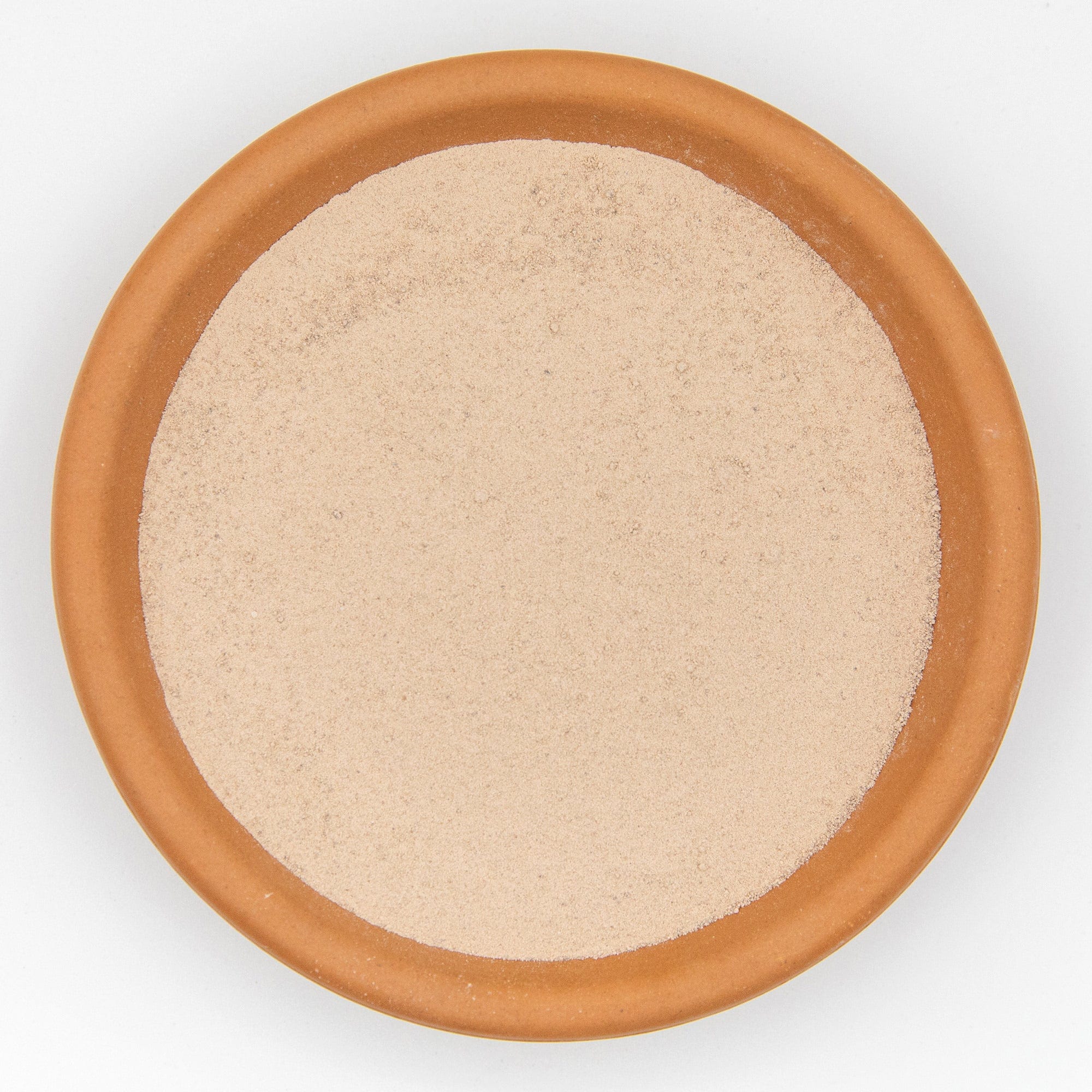Dolomite lime is used to add both calcium & magnesium to potting mixes and garden soils. It is used to increase the pH of soil and provide plants the calcium and magnesium they need.
Use between one and two cups per square meter, or between 1/4 to 1/2 cup per 30L of soil. Mix it into the soil or water in immediately after applying.
Other advantages:
- High in calcium and magnesium, both of which are vital for the health and growth of plants.
- Can be utilized to increase the soils pH levels, which is an important practice to making locked out nutrients available to the plant.
- Can be used to make nutrient-deficient soils more fertile.
- Can aid in enhancing aeration, water retention, and soil structure.
- Can be used to raise the pH of the soil, especially in cases when the soil is extremely acidic after prolonged rain events.
FAQs:
What exactly is Dolomite Lime, and what does it do?
Dolomite lime is finely ground calcium-magnesium carbonate. It raises acidic soil pH and supplies two key nutrients—calcium and magnesium—so plants can access nutrients better and grow stronger.
When should I use dolomite instead of regular garden lime?
Pick dolomite when you also want to add magnesium (or your soil test shows low Mg). Regular “garden” (calcitic) lime is mostly calcium; dolomite brings both calcium and magnesium.
What are the application rates for Dolomite Lime?
Use 1–2 cups per square metre in garden beds, or ¼–½ cup per 30 L of potting soil. Mix into soil or water in immediately after applying.
How do I apply Dolomite Lime to existing garden beds?
Broadcast the measured amount evenly, rake it into the top few centimetres, and water in well. For best results, apply ahead of planting so it has time to work.
How long does Dolomite Lime take to work?
You’ll usually see pH movement in weeks, with fuller effect over a few months. Finer powders react faster; pelletised limes are slower.
How often should I reapply?
Every 1–3 years is typical, guided by soil tests and rainfall/irrigation. Heavily leached or sandy soils may need it more often.
Do I need to test my soil before liming?
Highly recommended. Testing tells you current pH and magnesium status, so you can dose correctly and avoid over-liming.
Is Dolomite Lime safe for all plants?
Most veg, lawns and ornamentals that prefer neutral/slightly acidic soil benefit. Avoid or use sparingly with acid lovers (blueberries, azaleas, camellias, gardenias) that prefer low pH.
Can I use Dolomite Lime for tomatoes and fruiting veg?
Yes—if soil is acidic or low in calcium/magnesium. It helps with nutrient uptake and can reduce issues linked to Ca/Mg shortages. Don’t add lime to already neutral/alkaline soils.
Is Dolomite Lime OK for houseplants and indoor mixes?
Yes—sparingly. Mix ¼–½ cup per 30 L of potting mix if your water/soil runs acidic, then monitor pH. Skip it for acid-loving tropicals.
Can I add dolomite to compost?
A light sprinkle can buffer acidity and sweeten compost, but go easy—too much can stall decomposition.
Will Dolomite Lime help my lawn?
If your lawn soil is acidic, yes. Lime improves nutrient availability and root vigor. Always base rates on a soil test for your area.
Can I dissolve Dolomite Lime in a watering can?
It’s primarily a soil amendment, not a soluble feed. Some growers slurry fine powders for quick dust-free application, but the real action happens after it reacts in soil over time. Water in after applying.
How fine is the Dr Greenthumbs dolomite—powder or pellets?
It’s a fine powdered grade, which reacts faster than coarse/pelletised limes when incorporated and watered in.
What pack sizes do you offer?
1 kg and 2.5 kg. Handy sizes for pots, raised beds and small plots.
How far does a bag go?
As a rough guide, at 1 cup/m² a 1 kg bag will cover several square metres, depending on your soil’s needs and how densely you apply. Always follow the label rates above.
Can I use Dolomite Lime in hydroponics?
No—dolomite is a soil amendment. For hydro, manage pH with hydro-safe acids/bases and use Ca/Mg supplements designed for solution culture.
Will dolomite fix blossom end rot?
It can help prevent calcium-related issues by improving soil Ca availability if your soil is acidic/deficient. It won’t fix damage already present on fruit; correct watering and overall nutrition still matter.
Any plants I should avoid liming?
Yes—acid lovers like blueberries and azaleas generally resent lime. Keep their mixes on the acidic side.
Can I mix Dolomite Lime with fertiliser?
Apply lime separately from ammonium/urea-heavy fertilisers to reduce nitrogen loss and interactions. If using those fertilisers, leave a gap of a few weeks between applications, or water/fork in well.
Is over-liming a thing?
Yep. Too much lime can push pH too high, causing micronutrient lockouts (iron, manganese, zinc). That’s why soil tests and sensible rates matter.
How soon after liming can I plant?
You can plant soon after a light/top-up application that’s been watered in. For bigger pH corrections, apply weeks to months before planting so it has time to react.
Does rain affect Dolomite Lime?
Moisture helps it react, but long heavy rains can acidify soils over time—one reason periodic re-application may be needed in high-rainfall areas.
Can I use Dolomite Lime to stabilise pH in peat-heavy mixes?
Yes. Peat is acidic; a measured dose of dolomite helps buffer the mix toward neutral and adds Ca/Mg.
Is Dolomite Lime pet- or kid-safe?
It’s a mineral soil amendment, but the dust is alkaline and can irritate eyes, skin and lungs. Keep bags out of reach, avoid dust, and water in after application before pets/kids access the area.
What PPE should I use when applying?
Wear a dust mask/respirator, gloves and eye protection, and avoid windy days. Water in after spreading to settle dust.
Can I combine Dolomite Lime with gypsum?
They do different jobs: lime raises pH and adds Ca/Mg; gypsum adds calcium and sulphur without raising pH. Combine only if a soil test justifies both.
Will Dolomite Lime change my water’s pH?
It’s meant for soil, not adjusting irrigation water. If your tap water is very acidic, treat water separately; don’t rely on soil lime for that.
What’s the best season to lime?
Autumn to early spring is ideal—there’s time for a reaction before peak growth—but you can apply any time the soil isn’t waterlogged or bone-dry.
How do I know Dolomite Lime worked?
Retest soil pH 6–12 weeks after application (and again later). Watch for stronger growth, greener leaves, and fewer Ca/Mg-related deficiencies.
My plants yellowed after liming—what happened?
Often it’s over-liming or liming soils that weren’t actually acidic, which can lock out iron/manganese. Flush, add organic matter, and correct with targeted micronutrients or elemental sulphur where appropriate. Test first next time.
Can I return/exchange if I over-ordered?
Check our Returns Policy page for current details; unopened bags in resellable condition are typically easiest to sort.
Where is pickup available?
Click & Collect is available from our Bellambi, NSW store—see live availability on the product page.
Quick cheat-sheet (rates):
Garden beds: 1–2 cups/m²
Pots/mixes: ¼–½ cup per 30 L of soil
Always water in and retest pH before reapplying.


